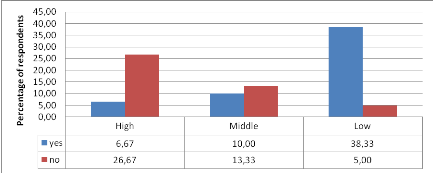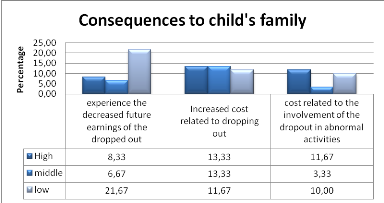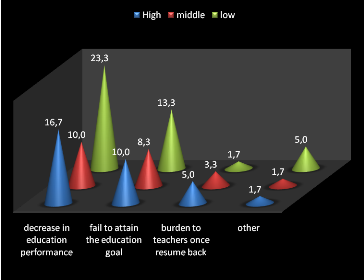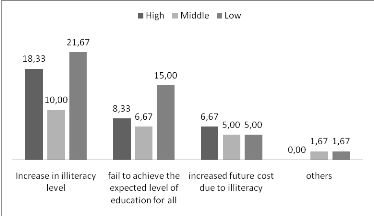4.3.5 Failure or repetition of
children
The figure 6 demonstrate that 42.6 percent representing the
highest percentage who agreed with that failure or repetition of children may
be a trigger to the decision of children to drop out were from the low level
of dropout schools against 23.4 percent representing the smallest who were from
the middle level ones. For those who against its influence, 46.2 percent
representing the highest value were from the low level of dropout schools
against 23.1 percent from the middle level ones.
Figure 5 Distribution of
respondents to whether the school has the program or no by the level of
dropout.

Source: primary data
According to the figure 5, illustration was made concerning
the level of dropout to whether the school has the program or does not. It is
shown that among schools with high level of dropout 26.67 percent were from
schools without the one cup of milk per child program against 6.67 percent from
schools with the program. Besides that, in the middle level of dropout schools
13.33 percent respondents were from schools with the program whereas other 10
percent were from schools without the program. Finally, among schools with the
low level of dropout 38.33 percent were from schools having the one cup of milk
per child program against 5 percent from schools without the program.
Figure 6 Figure showing the
distribution of consequences to child's family by the level of
dropout

Source: primary data
As illustrated in figure 6 above, to all respondents
questioned about the consequences families of dropped out children, 13.33
percent representing the highest percentage among schools with high level of
education replied that families experience the increased cost related to
dropping out of their children whereas 8.33 percent representing the lowest
percentage among schools with high level of education replied that families
experience the decreased future earnings of their dropped out children.
Moreover, among schools with middle level of dropout, 13.33 percent mentioned
that families face the increased cost related to dropout whereas 3.33 percent
(the lowest ratio) considered the cost related to the involvement of the
dropout in abnormal activities. Finally, among schools with low level of
dropout, 21.67 percent, representing the biggest ratio, replied that families
will be exposed to the decreased earnings in future from their children who
dropped out while only 10 percent standing for the lowest percentage among low
level of dropout schools said that the consequences to families of the dropped
out children will be among others the cost related to the involvement of their
children in abnormal activities.
Figure7 Distribution of
respondents to the consequences to school against the level of
dropout.

Source: primary data
Figure 7 shows that out of all respondents among schools with
high level of education, 23.3 percent mentioned decrease in education
performance as a major consequence from school dropout against 1.7 percent
representing the lowest percentage who said that dropout causes burden to
teachers once children are resuming back to their previous classes as they
would have progressed to next class levels. In addition, 10 percent among
schools with the middle level of dropout considered the major consequence
associated with dropout to be the decrease in education performance against
only 1.7 percent in the sense that consequences of dropout are out the
mentioned ones. Eventually, the 16.67 percent of respondents from schools with
low level of dropout suggested that decrease in education performance can be a
major consequence of school dropout whereas 1.7 percent did not find any of
those mentioned consequences but said that consequences associated with dropout
are not in range of the mentioned ones.
Figure 8 Distribution of
respondents regards consequences of dropout to a country by the level of
dropout.

| 


